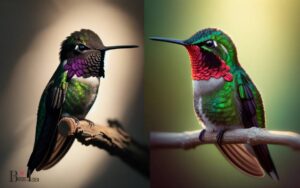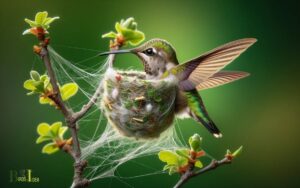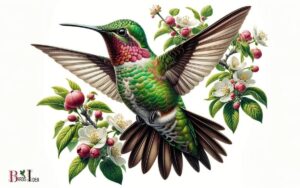Ruby Throated Vs Anna’s Hummingbird: Comparison!
The Ruby-throated Hummingbird and Anna’s Hummingbird are two distinct species with notable differences.
The Ruby-throated Hummingbird, primarily found in the eastern North America, is renowned for its iridescent ruby-red throat in males and its emerald or golden-green back.
Meanwhile, Anna’s Hummingbird, native to the west coast of North America, boasts a remarkable rose-pink throat and head in males, with a green back and grayish underparts.
Ruby-throated and Anna’s Hummingbirds differ in several ways:

Key Takeaway
3 Traits: Ruby Throated And Anna’s Hummingbird
| Trait | Ruby-throated Hummingbird | Anna’s Hummingbird |
|---|---|---|
| Range | Eastern North America | Western North America |
| Throat Color (male) | Ruby-red | Rose-pink |
| Size | Slightly smaller and slender | Slightly larger and stockier |
Physical Characteristics
The physical characteristics of Ruby Throated and Anna’s Hummingbirds exhibit notable differences in size, coloration, and wing shape. The Ruby Throated Hummingbird is approximately 3-3.5 inches in length and weighs around 3 grams.
It is identifiable by its metallic green back, white belly, and the ruby-red patch on the throat of the males, while the females have a whitish throat with green or black spots.
Conversely, Anna’s Hummingbird measures around 3.9-4.3 inches and weighs about 4-4.5 grams. The male Anna’s Hummingbird displays an iridescent pinkish-red crown and throat, whereas the female has a pale throat with some red spotting.
Additionally, the wing shape of the Ruby Throated Hummingbird is more pointed, while Anna’s Hummingbird has a slightly more rounded wing. These differences in physical characteristics contribute to their distinct behaviors and ecological roles.
Habitat Preferences
What environmental factors influence the habitat preferences of Ruby Throated and Anna’s Hummingbirds?
Both the Ruby Throated and Anna’s Hummingbirds have specific habitat preferences based on environmental factors.
- Climate: Ruby Throated Hummingbirds prefer the eastern half of North America, where the climate is warmer and more humid, while Anna’s Hummingbirds are found along the western coast of North America, where the climate is milder and more temperate.
- Vegetation: Ruby Throated Hummingbirds favor habitats with a mix of open woodlands and meadows, while Anna’s Hummingbirds are commonly found in more urban and suburban settings with a variety of flowering plants.
- Altitude: Ruby Throated Hummingbirds are typically found at lower elevations, while Anna’s Hummingbirds can be found at higher elevations, up to 12,000 feet in some cases.
Understanding these habitat preferences is crucial for conservation efforts and creating suitable environments for these magnificent birds.
Feeding Behaviors
Both Ruby Throated and Anna’s Hummingbirds demonstrate distinct feeding behaviors influenced by their habitat preferences and physiological adaptations.
Ruby Throated Hummingbirds primarily feed on nectar from brightly colored, tubular flowers, but they also catch insects in mid-air. Anna’s Hummingbirds, on the other hand, have a diverse diet that includes nectar, insects, and tree sap.
They are known to be more aggressive and territorial around feeding areas, often defending them vigorously.
The following table provides a comparative overview of the feeding behaviors of both species:
| Feeding Behaviors | Ruby Throated Hummingbird | Anna’s Hummingbird |
|---|---|---|
| Primary Diet | Nectar and insects | Nectar, insects, and tree sap |
| Foraging Technique | Catching insects in mid-air | Diverse foraging techniques |
| Territorial Behavior | Less aggressive | More aggressive and territorial |
These feeding behaviors are essential for the survival and reproduction of both species in their respective habitats.
Mating and Reproduction
In the context of mating and reproduction, a critical aspect of the comparative analysis between the Ruby Throated and Anna’s Hummingbirds is their distinct mating behaviors and reproductive strategies.
- Mating Displays: Male Ruby Throated Hummingbirds perform elaborate aerial displays to attract females, while male Anna’s Hummingbirds showcase their vibrant iridescent feathers during courtship.
- Nesting Habits: Ruby Throated Hummingbirds build their cup-shaped nests using plant fibers and spider silk, often camouflaging them with lichens, while Anna’s Hummingbirds construct compact, well-insulated nests using materials like moss and lichen.
- Incubation and Fledging: Female Ruby Throated Hummingbirds alone incubate the eggs, while both male and female Anna’s Hummingbirds take turns incubating and feeding the young.
Understanding these differences in mating and reproductive behaviors provides valuable insights into the unique evolutionary adaptations of these two hummingbird species.
Vocalizations and Communication
When comparing the vocalizations of the Ruby Throated and Anna’s Hummingbirds, distinct differences can be observed.
The Ruby Throated Hummingbird is known for its sharp, high-pitched chirping, while the Anna’s Hummingbird produces a more varied and complex array of sounds, including chattering and squeaking.
In terms of communication methods, both species utilize vocalizations to defend their territories and attract mates, but the specific patterns and frequencies of their calls differ significantly.
Vocalization Differences
The vocalizations of the Ruby Throated and Anna’s Hummingbirds exhibit distinct patterns and frequencies, contributing to their unique communication styles. These differences are essential for their survival and reproductive success.
Here are some key differences in their vocalizations:
- Frequency: The Ruby Throated Hummingbird produces vocalizations at a higher frequency range, typically between 2.5 to 5.5 kHz, whereas the Anna’s Hummingbird vocalizations are in a lower frequency range, around 1 to 2 kHz.
- Patterns: Ruby Throated Hummingbirds often create short, repetitive chirps and buzzing sounds, while Anna’s Hummingbirds are known for longer, complex vocal patterns with varying pitch and amplitude.
- Function: The vocalizations of both species serve various purposes, including attracting mates, defending territory, and signaling distress.
Understanding these vocalization differences provides valuable insights into the communication behaviors of these fascinating birds. This leads us to the next section, where we will explore their communication methods in more detail.
Communication Methods
Communication methods among the Ruby Throated and Anna’s Hummingbirds encompass various forms of vocalizations and non-vocal behaviors, which are integral to their interactions and survival strategies.
Ruby Throated Hummingbirds are known for their distinct high-pitched vocalizations, often used during courtship displays or territorial disputes. These vocalizations consist of varied chirps and trills, which are essential for attracting mates and establishing territories.
In contrast, Anna’s Hummingbirds also utilize vocalizations for similar purposes, but their calls are characterized by a raspier and more aggressive tone compared to the Ruby Throated.
Additionally, both species rely on non-vocal behaviors such as aerial displays and physical posturing to communicate dominance or submission.
Understanding these communication methods provides valuable insights into the intricate social dynamics and survival strategies of these fascinating hummingbird species.
Migration Patterns
Migration patterns of the Ruby Throated and Anna’s Hummingbird differ significantly due to their distinct breeding and wintering ranges.
- Breeding Range: The Ruby Throated Hummingbird breeds throughout eastern North America, from southern Canada to the Gulf of Mexico, while the Anna’s Hummingbird breeds along the western coast of North America, from southern Alaska to Baja California.
- Wintering Range: The Ruby Throated Hummingbird migrates across the Gulf of Mexico to spend the winter in Central America, whereas the Anna’s Hummingbird is mostly non-migratory, with some populations residing in their breeding range year-round.
- Migration Distance: Ruby Throated Hummingbirds undertake one of the longest migratory journeys of any hummingbird species, traveling up to 3,000 miles, while the Anna’s Hummingbird’s non-migratory behavior means it does not undertake long-distance migrations.
Interactions With Humans
Human interactions with both the Ruby Throated and Anna’s Hummingbird have been documented since the 19th century, revealing insights into their behaviors and ecological significance.
Both species have adapted to human presence, often frequenting gardens and feeders, providing opportunities for close observation.
Ruby Throated Hummingbirds are known to readily feed from artificial nectar feeders, while Anna’s Hummingbirds have also been observed to exhibit similar behavior.
However, these interactions can have both positive and negative impacts on the birds. While feeders can provide vital food sources, they can also lead to increased competition and aggression.
Furthermore, human activities such as habitat destruction and pesticide use can negatively impact both species.
Understanding these interactions is crucial for conservation efforts and promoting harmonious coexistence between humans and these remarkable birds.
Conservation Status
The conservation status of the Ruby-throated and Anna’s hummingbirds is of paramount concern due to threats to their habitats and the causes of population decline.
Both species face habitat loss due to deforestation, urban development, and climate change, which are leading to a decline in suitable breeding and foraging areas.
Additionally, other factors such as pesticide use, competition with non-native species, and the disruption of migration patterns also contribute to the conservation challenges faced by these hummingbirds.
Threats to Habitats
Habitat destruction poses a significant threat to the conservation status of both Ruby Throated and Anna’s Hummingbirds.
The following factors contribute to the threat to their habitats:
- Deforestation: The clearing of forests for agriculture, urban development, and logging directly reduces the availability of suitable habitats for both species of hummingbirds.
- Climate Change: The alteration of temperature and precipitation patterns can impact the availability of nectar-producing flowers, which are crucial food sources for hummingbirds.
- Urbanization: The expansion of urban areas can lead to habitat fragmentation and loss of natural spaces, limiting the areas where hummingbirds can find suitable nesting sites and food sources.
These threats highlight the importance of conservation efforts to protect the habitats of Ruby Throated and Anna’s Hummingbirds to ensure their long-term survival.
Population Decline Causes
A critical factor contributing to the population decline of both Ruby Throated and Anna’s Hummingbirds is the loss of suitable nesting and foraging sites due to habitat destruction, leading to their conservation status being threatened.
| Population Decline Causes | Ruby Throated Hummingbird | Anna’s Hummingbird |
|---|---|---|
| Habitat Destruction | Loss of suitable nesting and foraging sites | Loss of suitable nesting and foraging sites |
| Climate Change | Vulnerable to changes in climate affecting food sources | Vulnerable to changes in climate affecting food sources |
| Pesticide Use | Susceptible to negative effects of pesticides on food sources | Susceptible to negative effects of pesticides on food sources |
| Predation | Increased vulnerability due to habitat fragmentation | Increased vulnerability due to habitat fragmentation |
The table above illustrates the main causes of population decline for both species, highlighting their shared vulnerabilities to common threats.
Efforts to address these causes are crucial for the conservation of both Ruby Throated and Anna’s Hummingbirds.
Conclusion
The ruby-throated hummingbird and Anna’s hummingbird exhibit distinct physical characteristics, habitat preferences, feeding behaviors, mating and reproduction strategies, vocalizations, migration patterns, and interactions with humans.
Despite their differences, both species play crucial roles in maintaining ecological balance and biodiversity. With their delicate beauty and remarkable abilities, have you ever wondered how these tiny creatures have adapted to thrive in diverse environments?






